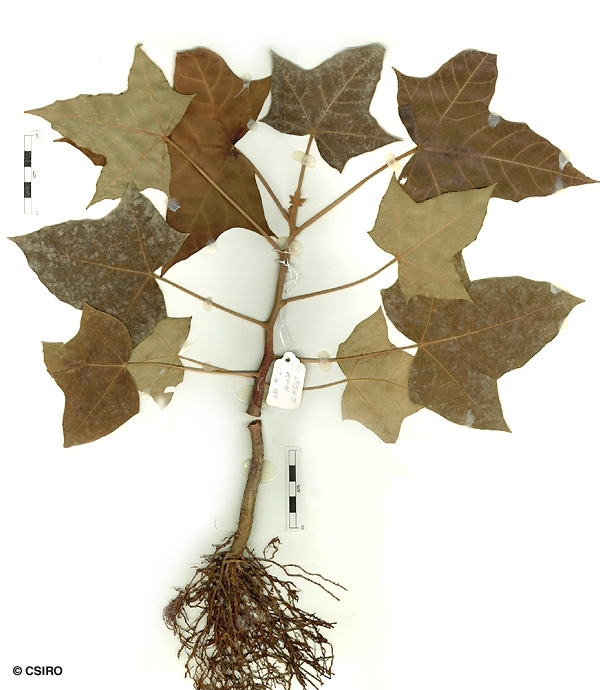Australian Tropical Rainforest Plants - Online edition
Aleurites moluccanus (L.) Willd.






Willdenow, C.L. von (1806) Species Plantarum ed. 4 4(1): 590. Type: Habitat in Moluccis, Zeylona.
Bark of large trees usually divided into large plates. Inner blaze sometimes layered.
One or two conspicuously raised green or almost black glands on the upper surface of the petiole near its junction with the leaf blade. Leaf blades about 7-20 x 4-13 cm. Oil dots visible with a lens. Underside of the leaf blade clothed in brown stellate hairs or scales. Young shoots and terminal buds densely clothed in cream or brown hairs many of which are stellate.
Fruits about 4-6 cm diam., usually 2-lobed, sometimes reduced to one. The rat-eaten remains of the hard, spherical seed coats (about 2 cm diam.) normally present under large trees.
Cotyledons oblong to obovoid. First pair of leaves +/- cordate, base +/- truncate, margin lobed. At the tenth leaf stage: leaf blade palmatifid, apex acute or acuminate, base hastate, both the upper and lower surfaces with pale brown stellate hairs near the base and along the midrib and main lateral veins; oil dots small, scattered; two glands occur on the upper surface of the petiole near its junction with the leaf blade. Petiole, stem and terminal bud clothed in numerous brown stellate hairs. Seed germination time 27 days.
Occurs in CYP, NEQ and CEQ, mostly north from the Daintree River and the Windsor Tableland areas, with an isolated occurrence in coastal central Queensland. Altitudinal range from near sea level to 800 m. A fast growing tree which often grows in disturbed rain forest but also found in well developed rain forest and gallery forest. Also occurs in Asia, Malesia and the Pacific islands.
The seeds of this species are sometimes regarded as edible but considerable caution should be exercised as the seeds of most species of Aleurites contain poisonous compounds. Everist (1974).
This species may have medicinal properties.
The nuts, and the oil extracted from them, are strongly purging if eaten raw, and have been used medicinally in India and South-east Asia as a laxative. Cribb (1981).





